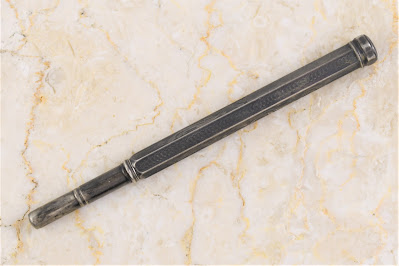This article has been included in The Leadhead's Pencil Blog Volume 7, now available here.
If you don't want the book but you enjoy the article, please consider supporting the Blog project here.
Before I delve headlong down the other rabbit hole from that second Victorian mini-hoard, yesterday’s article provided the perfect introduction to show you something else. Since they come up so rarely, they don’t introduce themselves . . . so with the door opened, now is as good a time as any to walk on through:
Eric Magnuson had prevailed on me to take an Eversharp lead display off of his hands – because it was too big and bulky, rather than because he didn’t like it. Since he was going to press his parents into service to lug it back to Columbus with them after a planned visit his new home in Illiniois, he sent me pictures of a few other items that might be good stowaways for the journey, this one included.
“It’s a Deacon,” Eric said. That was all it took for me to book this little guy budget accommodations in the storage cabin for the ride.
“Our old friend Edward Deacon,” I referred to the maker in yesterday’s piece. Deacon was an early New York manufacturer and an early associate of William S. Hicks (see Volume 4, page 176 – Deacon’s biography is covered on pages 177-179). A few weeks after that article was written, I finally found my first Deacon at the Ohio Pen Show (Volume 4, page 269).
Edward Deacon was apparently a very prolific manufacturer, one of the few who was successful enough to place a flashy advertisement in the 1850 New York Directory:
Since so few examples survive which are stamped with his name, I’m assuming that most of what he made were unmarked combination dip pens and pencils, later equipped with nibs from other New York houses. When this one arrived, I thought this might be along the same lines, but it has an interesting omission:
It has a reversible pencil section, but unlike most of what you’ll find along these lines, there’s no holder on the other side for a nib. In addition, the barrel extends for more comfortable writing, and with good reason: when it arrived, I was surprised at how small this piece is. My other example of Edward Deacon’s work dwarfs this new specimen . . . at least, until it is fully extended:
Deacon, according to my research concerning William S. Hicks, first appears in New York as a “silverworker” in 1837. His occupation is listed as “pencil cases” beginning in 1842, and he disappears from New York directories after his listing in the 1852 directory (alongside Zachariah Dederick). That provides just a ten-year window during which both of my Deacon-marked pencils were made.
I’m sure more interesting examples of these early pencils – and maybe a pen – will surface in the future, and as they do I’ll have to reintroduce him again.






No comments:
Post a Comment